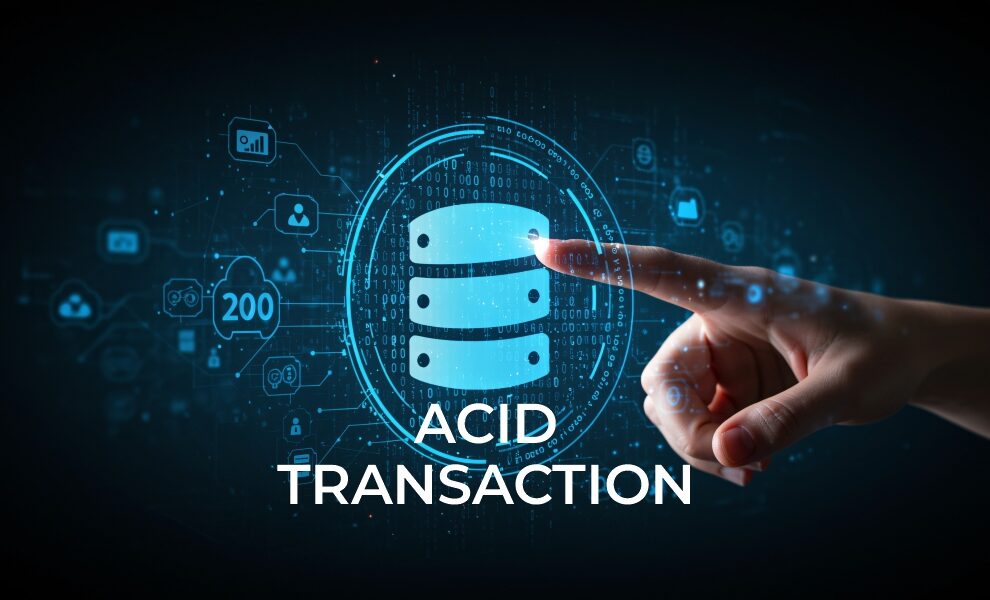Imagine you are transferring money to your friends. In the middle of it, the system fails. Your funds are debited from your account, but they are not transferred to the receiver’s account. Without safeguards, your funds might be gone or taken from your account. This worst-case scenario is precisely what ACID transactions avoid in databases.
When we use digital services to swipe a credit card, send money, buy flights, or shop online, we think that the underlying data for these activities is secure. Have you ever thought of what makes these transactions secure? How is our data kept safe from errors? It happens due to the basic principles of ACID (atomicity, consistency, isolation, and durability) that guide the way databases conduct transactions.
These four principles keep databases consistent and accurate, and even if something goes wrong, it can handle precisely. Whether you are handling bank transfers, medical records, or web orders, ACID makes sure that your information remains secure, correct, and reliable. Let’s understand this in detail.
What are ACID Transactions?
A database transaction is a set of one or more operations reading, writing, or updating data, on which all the operations should be atomic; that is, they should be executed as a single unit of work. Either all the operations in the set are successful, or all fail. It is an all-or-nothing situation.
To ensure safe and reliable results, the database applies the ACID rules. When a database is ACID transaction-capable, that means you can be sure that:
- Your information remains accurate and consistent.
- Half of a change never “leaks” into the system.
- Multiple users simultaneously don’t overwrite each other’s work.
As soon as your information is written, even a crash or power loss can’t change that.
The Four Pillars of ACID
1. Atomicity: Everything Happens Together or Not at All
Atomicity is a set of actions in a transaction, in which either all actions happen together or nothing happens at all. Think of it like a row of dominoes; if one does not fall, the rest will also not fall.
For example, while sending money from account A to account B, atomicity makes sure that the whole process will work either smoothly and successfully or else not. If something goes wrong during the process, atomicity makes sure the whole thing is canceled. So no money is lost or wrongly added.
How is it done?
Contemporary databases employ devices such as rollback logs. If something goes wrong at any point, the entire sequence is rolled back as if nothing had occurred, so there are never “in-between” states.
2. Consistency: Maintaining Data Validity
Consistency ensures that a transaction will only transition the database from one valid state to another. It makes sure that all data rules are not violated.
For example, if you try to register an already existing email address in the database, consistency rules will reject the action and prevent duplicate records.
How is it done?
Consistency depends on constraints such as unique keys, foreign keys, and additional validation rules. Transactions cannot violate these rules, or they get rejected, and no bad data ends up in the database.
3. Isolation: Safe Parallel Processing
Isolation makes sure that transactions do not mix with one another. When several individuals are making changes at once. Each transaction acts as if it is occurring independently, even when dozens of them execute at the same time.
For example, when two users try to purchase the last ticket to a concert, there will be a situation where only one transaction can happen successfully. Here, both transactions are done separately, but only one of them was able to complete and get the ticket.
How is it done?
Locks and other isolation mechanisms in databases isolate transactions. Some provide “snapshot” or “serializable” isolation, where each transaction gets to see its own “version” of the data until it completes.
4. Durability: Safety After Commit
Durability makes sure that once a transaction is done (committed), its effects are permanent even if the system crashes a second later.
For example, you order something online and pay for it. Suddenly, the site goes down. With durability, your purchase will not vanish, because the database made sure to save that change in a manner that will survive power failures or hardware failures.
How is it done?
Databases commit transactions to durable storage (such as hard disks or SSDs) with transaction logs and backup methods. That is, no committed data is ever lost.
Why Are ACID Properties So Important?
Without ACID transactions, databases might lose, damage, or leak in-progress data, incurring failed bank transfers, missing orders, or even security breaches.
The following are some practical reasons ACID is important:
Financial Transfers: Banks avoid errors such as double withdrawals or forgotten deposits.
E-commerce: Web shops ensure that your payment and order are always consistent, with no lost updates.
Healthcare: Medical records are always accurate, never partially updated or lost, regardless of who uses them.
Multi-user Situations: Tens (or hundreds) of staff members can use the same records without creating confusion.
How Do Databases Ensure ACID Guarantees?
The majority of contemporary databases are designed with ACID transactions. For example, relational databases such as MySQL, PostgreSQL, Oracle, and SQL Server. They have capabilities such as:
- Transaction Commands: BEGIN, COMMIT, and ROLLBACK to manage the order of operations.
- Local and Concurrency Controls: To maintain isolation and avoid conflicting changes.
- Transaction Logs: To provide atomicity and durability, keep a record of all operations for recovery upon failures.
- Constraints and Triggers: To enforce consistency through rule checking prior to committing modifications.
Certain distributed and NoSQL databases also implement support for ACID, though often at the cost of performance or scalability. More recent technologies, such as Google Spanner and CockroachDB, provide ACID. This allows consistent transactions at a large scale.
Final Thoughts: Trust in Every Transaction
ACID transactions properties form the foundation of reliable databases. By following atomicity, consistency, isolation, and durability, databases protect our online lives from mistakes, interruptions, and breaches. If you are a developer, business owner, or casual user, ACID’s unseen protection works in your favor. This gives you confidence that your information is always whole, correct, and safely saved.
For such informative blogs, visit HiTechNectar!
FAQs
Q1. What are atomicity, consistency, isolation, and durability?
Answer: There are rules that keep database transactions safe and correct:
- Atomicity: All steps succeed or none at all.
- Consistency: Data stays valid and follows rules.
- Isolation: Transactions don’t affect each other.
- Durability: Once saved, data will not be lost.
Q2. Do all databases support ACID transactions?
Answer: Many relational databases (SQL-based) support ACID. Some NoSQL databases give importance to speed over strict ACID but offer eventual consistency or partial compliance.
Q3. Can ACID transactions slow down a database?
Answer: Yes, enforcing strict ACID can impact performance. That’s why some high-speed systems use relaxed consistency models, but critical applications always need ACID guarantees.
Recommended reading:
Detailed Framework About Flat Files Database
Understanding the Difference Between Database Sharding and Partitioning
Database Management System Software Perform Operations Like Creating, Storing or Deleting Data


